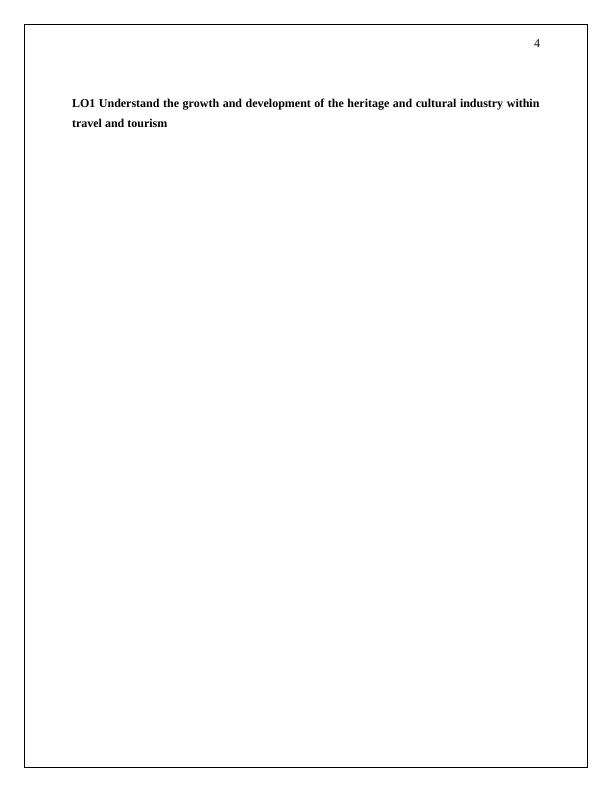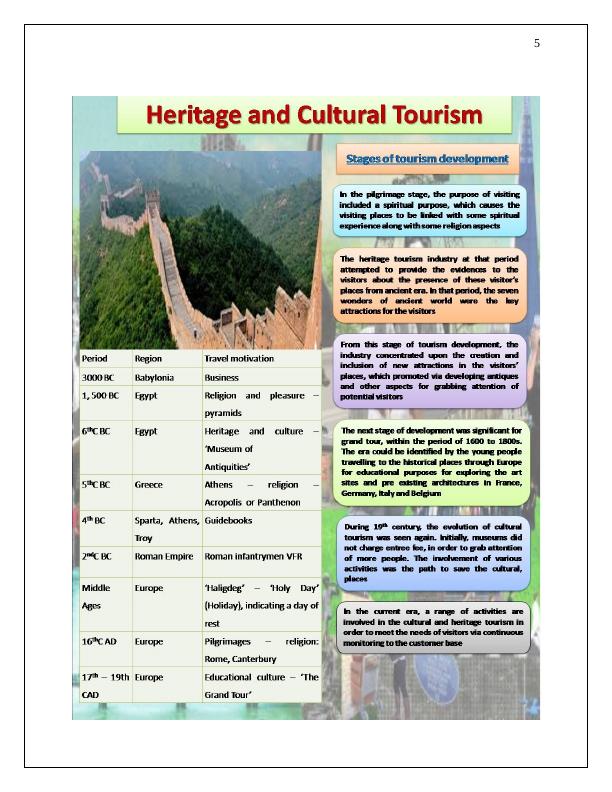HERITAGE AND CULTURAL TOURISM MANAGEMENT
Added on 2024-04-25
23 Pages6059 Words53 Views
1
HERITAGE AND CULTURAL TOURISM MANAGEMENT
HERITAGE AND CULTURAL TOURISM MANAGEMENT

2
Table of Contents
Introduction......................................................................................................................................3
LO1 Understand the growth and development of the heritage and cultural industry within travel
and tourism......................................................................................................................................4
1.1 Analyze the growth and development of the heritage and cultural industry........................6
1.2 Discuss potential conflicts in the conservation of heritage and cultural resources: Case
study of Barcelona (Spain) and Venice (Italy)................................................................................8
LO2 Understand the purpose of heritage and cultural attractions within the travel and tourism
sector..............................................................................................................................................10
2.1 Assess the purpose of heritage and cultural attractions in meeting the needs of different
customers.......................................................................................................................................10
Task 3.............................................................................................................................................12
3.1 Evaluate the impact of different types of ownership on the management of heritage and
cultural sites...................................................................................................................................12
3.2 Analyze roles and responsibilities of organizations in the heritage and cultural industry......14
Task 4.............................................................................................................................................17
4.1 Evaluate methods and media used for interpretation within the heritage and cultural industry
for tourists......................................................................................................................................18
Conclusion.....................................................................................................................................21
Reference list.................................................................................................................................22
Table of Contents
Introduction......................................................................................................................................3
LO1 Understand the growth and development of the heritage and cultural industry within travel
and tourism......................................................................................................................................4
1.1 Analyze the growth and development of the heritage and cultural industry........................6
1.2 Discuss potential conflicts in the conservation of heritage and cultural resources: Case
study of Barcelona (Spain) and Venice (Italy)................................................................................8
LO2 Understand the purpose of heritage and cultural attractions within the travel and tourism
sector..............................................................................................................................................10
2.1 Assess the purpose of heritage and cultural attractions in meeting the needs of different
customers.......................................................................................................................................10
Task 3.............................................................................................................................................12
3.1 Evaluate the impact of different types of ownership on the management of heritage and
cultural sites...................................................................................................................................12
3.2 Analyze roles and responsibilities of organizations in the heritage and cultural industry......14
Task 4.............................................................................................................................................17
4.1 Evaluate methods and media used for interpretation within the heritage and cultural industry
for tourists......................................................................................................................................18
Conclusion.....................................................................................................................................21
Reference list.................................................................................................................................22

3
Introduction
Travel and tourism is one of the largest industries in the world. This sector is associated with the
leisure and travel activities for the interested tourist. The particular sector is behind the
employment of 200 million people throughout the world. The industry is providing leisure and
other travel activities in domestic or international context. In this context, it is also noteworthy
that the visiting places are significant source of income in many places, especially in case of
heritage or cultural places, where cultural and historical aspects were kept safely. In addition, by
strengthening the international relations in regards to the social, cultural, educational and
economic sectors, the sector is directly contributing in social wellbeing (Iriye and Saunier, 2016).
The current assignment would focus upon the heritage and cultural assets management in the
travel and tourism industry. Initially, the growth and development of the heritage and cultural
industry in this sector would be demonstrated here, followed by the demonstration of the purpose
of maintaining and keeping these heritage and cultural attractions safe in the travel and tourism
sector. In the following section, the roles and responsibilities of the owners of heritage and
cultural industry has also been discussed here. Finally, the key methods for interpreting the
heritage and cultural industry have been demonstrated in the assignment.
Introduction
Travel and tourism is one of the largest industries in the world. This sector is associated with the
leisure and travel activities for the interested tourist. The particular sector is behind the
employment of 200 million people throughout the world. The industry is providing leisure and
other travel activities in domestic or international context. In this context, it is also noteworthy
that the visiting places are significant source of income in many places, especially in case of
heritage or cultural places, where cultural and historical aspects were kept safely. In addition, by
strengthening the international relations in regards to the social, cultural, educational and
economic sectors, the sector is directly contributing in social wellbeing (Iriye and Saunier, 2016).
The current assignment would focus upon the heritage and cultural assets management in the
travel and tourism industry. Initially, the growth and development of the heritage and cultural
industry in this sector would be demonstrated here, followed by the demonstration of the purpose
of maintaining and keeping these heritage and cultural attractions safe in the travel and tourism
sector. In the following section, the roles and responsibilities of the owners of heritage and
cultural industry has also been discussed here. Finally, the key methods for interpreting the
heritage and cultural industry have been demonstrated in the assignment.

4
LO1 Understand the growth and development of the heritage and cultural industry within
travel and tourism
LO1 Understand the growth and development of the heritage and cultural industry within
travel and tourism

5

6
1.1 Analyze the growth and development of the heritage and cultural industry
It is important to understand the heritage tourism, prior understanding the growth and
development of this industry. The heritage tourism involves cultural and historical assets along
with natural resources, where visitors come to explore their interest. It has several importances,
including the positive social and economic impact upon the society. In addition, the heritage
tourism helps to establish the image and identity of the cultural places, while contributing
significantly in preserving those assets within the community. It makes the bridge, allowing the
culture to promote harmony and collaboration within communities and society people. The
heritage tourism is supporting the hospitality sector through the preservations of the cultural
aspects. For instance, in UK, there are approx 30 UNESCO recognized heritage sites along with
the natural assets including Henderson Island, Gough and Inaccessible Islands. On the other
hand, some these sites are archeological places as well as some places are cultural and historical
places like Maritime Geenwich, Royal Botanical Gardens, Westminster Abbey, and Saint
Margaret’s Church (Timothy, 2014).
The growth and development of the heritage and cultural tourism can be understood through the
evolving stages of society, from the pilgrimage to the current era. In the pilgrimage stage, the
purpose of visiting included a spiritual purpose, which causes the visiting places to be linked
with some spiritual experience along with some religion aspects; like the burial site of a famous
people, places having mystical significance and places where miracles took place, were the key
visitor’s attractions at that period.
In the sequence, the next era focused upon ancient and biblical attributes as the key visitor’s
attractions in the heritage tourism. The heritage tourism industry at that period attempted to
provide the evidences to the visitors about the presence of these visitor’s places from ancient era.
For instance, it is evident that the Greek citizens, keen to explore the heritage sites, used to go to
Egypt, where their tour guides provide them the instructions regarding the story and ancient facts
associated with the places they visited. In that period, the seven wonders of ancient world were
the key attractions for the (Moufakkir and Reisinger, 2013).
The next stage of tourism development was at the age of Renaissance, within the period of 14th to
17th centuries, when the heritage tourism included the attributes related to ancient Rome and
Greece. From this stage of tourism development, the industry concentrated upon the creation and
1.1 Analyze the growth and development of the heritage and cultural industry
It is important to understand the heritage tourism, prior understanding the growth and
development of this industry. The heritage tourism involves cultural and historical assets along
with natural resources, where visitors come to explore their interest. It has several importances,
including the positive social and economic impact upon the society. In addition, the heritage
tourism helps to establish the image and identity of the cultural places, while contributing
significantly in preserving those assets within the community. It makes the bridge, allowing the
culture to promote harmony and collaboration within communities and society people. The
heritage tourism is supporting the hospitality sector through the preservations of the cultural
aspects. For instance, in UK, there are approx 30 UNESCO recognized heritage sites along with
the natural assets including Henderson Island, Gough and Inaccessible Islands. On the other
hand, some these sites are archeological places as well as some places are cultural and historical
places like Maritime Geenwich, Royal Botanical Gardens, Westminster Abbey, and Saint
Margaret’s Church (Timothy, 2014).
The growth and development of the heritage and cultural tourism can be understood through the
evolving stages of society, from the pilgrimage to the current era. In the pilgrimage stage, the
purpose of visiting included a spiritual purpose, which causes the visiting places to be linked
with some spiritual experience along with some religion aspects; like the burial site of a famous
people, places having mystical significance and places where miracles took place, were the key
visitor’s attractions at that period.
In the sequence, the next era focused upon ancient and biblical attributes as the key visitor’s
attractions in the heritage tourism. The heritage tourism industry at that period attempted to
provide the evidences to the visitors about the presence of these visitor’s places from ancient era.
For instance, it is evident that the Greek citizens, keen to explore the heritage sites, used to go to
Egypt, where their tour guides provide them the instructions regarding the story and ancient facts
associated with the places they visited. In that period, the seven wonders of ancient world were
the key attractions for the (Moufakkir and Reisinger, 2013).
The next stage of tourism development was at the age of Renaissance, within the period of 14th to
17th centuries, when the heritage tourism included the attributes related to ancient Rome and
Greece. From this stage of tourism development, the industry concentrated upon the creation and

End of preview
Want to access all the pages? Upload your documents or become a member.
Related Documents
Understanding the growth and development of the heritage and cultural tourism industry within travel and tourismlg...
|14
|3674
|53
Development of Heritage and Cultural Industry within Travel and Tourism : Reportlg...
|20
|5197
|37
Assignment- Growth & Development In Heritage & Cultural Industrylg...
|17
|4254
|135
InTRODUCTION 3 TASK 13 1.1 The UK heritage and cultural tourism industrylg...
|15
|5270
|96
Heritage and Cultural Tourism Managementlg...
|15
|4275
|53
Assignment of Heritage and Cultural Tourism Managementlg...
|16
|3550
|226
